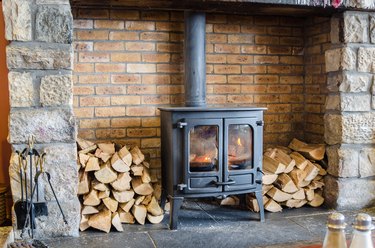
If you have a standard fireplace in your home, you might notice that it doesn't put out quite enough heat to keep you comfortable on a cold day, because almost all of the heat is going out the chimney. If your fireplace has a damper, which is essentially a chimney baffle plate, you can improve the situation by closing it a little to keep some of the hot gases in the fireplace, which will raise the temperature. A stove baffle is a permanent fixture inside a wood stove that works the same way, and it's one of the reasons a wood stove heats a home better than a fireplace.
Wood Heater Baffle Plate Basics
Video of the Day
In a general sense, a baffle is a barrier that restricts the flow of a gas or liquid to produce a desired result. The baffle in a septic tank, for example, is a plate placed between the inflow and outflow sections of the tank. The plate allows water to flow over it but not under. This causes solid waste in the water to settle to the bottom of the tank, thus preventing it from flowing out to the drain field, where it would cause clogging.
Video of the Day
The baffle plate in a wood stove operates in a similar manner. It's usually placed between the firebox and the chimney, and it reduces the air passage to a small opening between the top of the baffle and the roof of the stove. Because combustion gases can't get out easily, they recirculate through the stove, going through additional combustion and raising the temperature of the fire.
Baffle Construction and Material
A wood stove baffle is often a plate or wall that divides the firebox into sections, but it doesn't have to be. In some stoves, it's little more than a disk that partially covers the chimney opening. It's a baffle as long as it performs the required function, which is to restrict the flow of combustion gases through the chimney, and some stove manufacturers refer to it as a throat or deflector plate.
The baffle plate must be made of a durable material to withstand all that heat. Some common baffle materials, according to The Stove Yard, include cast iron, heavy steel, stainless steel and vermiculite, a natural silicate mineral known for its heat-resistance. The baffle in some larger stoves is constructed from fire brick.
Despite being made of such heavy-duty materials, baffles can and do wear out and usually aren't covered by warranty. You can make your baffle last longer by following the user instructions for your stove, burning the right kind of wood and refraining from overfilling the firebox to get more heat. If the stove performance is less than it should be because the baffle plate fell down or burnt out, then you'll have to replace the baffle at your own expense, no matter why it happened.
Baffle or Damper?
The damper in a wood stove is typically located in the flue, which is the pipe that leads from the stove to the exhaust system. There's usually a control handle on the stove or the flue. When the fire is burning, you can partially close the damper to restrict the flow of gases and make the fire hotter, which is the same thing a baffle does. However, you can also open it to make the fire less hot, so it's actually a kind of throttle or temperature regulator. A baffle, on the other hand, is a permanent fixture, and there's no way to adjust it.